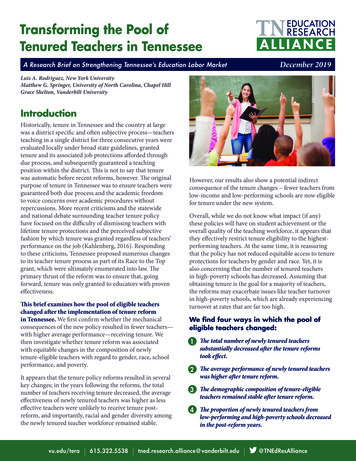
Transcription
Transforming the Pool ofTenured Teachers in TennesseeDecember 2019A Research Brief on Strengthening Tennessee’s Education Labor MarketLuis A. Rodriguez, New York UniversityMatthew G. Springer, University of North Carolina, Chapel HillGrace Shelton, Vanderbilt UniversityIntroductionHistorically, tenure in Tennessee and the country at largewas a district specific and often subjective process—teachersteaching in a single district for three consecutive years wereevaluated locally under broad state guidelines, grantedtenure and its associated job protections afforded throughdue process, and subsequently guaranteed a teachingposition within the district. This is not to say that tenurewas automatic before recent reforms, however. The originalpurpose of tenure in Tennessee was to ensure teachers wereguaranteed both due process and the academic freedomto voice concerns over academic procedures withoutrepercussions. More recent criticisms and the statewideand national debate surrounding teacher tenure policyhave focused on the difficulty of dismissing teachers withlifetime tenure protections and the perceived subjectivefashion by which tenure was granted regardless of teachers’performance on the job (Kahlenberg, 2016). Respondingto these criticisms, Tennessee proposed numerous changesto its teacher tenure process as part of its Race to the Topgrant, which were ultimately enumerated into law. Theprimary thrust of the reform was to ensure that, goingforward, tenure was only granted to educators with proveneffectiveness.This brief examines how the pool of eligible teacherschanged after the implementation of tenure reformin Tennessee. We first confirm whether the mechanicalconsequences of the new policy resulted in fewer teachers—with higher average performance—receiving tenure. Wethen investigate whether tenure reform was associatedwith equitable changes in the composition of newlytenure-eligible teachers with regard to gender, race, schoolperformance, and poverty.It appears that the tenure policy reforms resulted in severalkey changes; in the years following the reforms, the totalnumber of teachers receiving tenure decreased, the averageeffectiveness of newly tenured teachers was higher as lesseffective teachers were unlikely to receive tenure postreform, and importantly, racial and gender diversity amongthe newly tenured teacher workforce remained stable.vu.edu/tera 615.322.5538 However, our results also show a potential indirectconsequence of the tenure changes – fewer teachers fromlow-income and low-performing schools are now eligiblefor tenure under the new system.Overall, while we do not know what impact (if any)these policies will have on student achievement or theoverall quality of the teaching workforce, it appears thatthey effectively restrict tenure eligibility to the highestperforming teachers. At the same time, it is reassuringthat the policy has not reduced equitable access to tenureprotections for teachers by gender and race. Yet, it isalso concerning that the number of tenured teachersin high-poverty schools has decreased. Assuming thatobtaining tenure is the goal for a majority of teachers,the reforms may exacerbate issues like teacher turnoverin high-poverty schools, which are already experiencingturnover at rates that are far too high.We find four ways in which the pool ofeligible teachers changed:1 The total number of newly tenured teacherssubstantially decreased after the tenure reformstook effect.2 The average performance of newly tenured teacherswas higher after tenure reform.3 The demographic composition of tenure-eligibleteachers remained stable after tenure reform.4 The proportion of newly tenured teachers fromlow-performing and high-poverty schools decreasedin the post-reform years.tned.research.alliance@vanderbilt.edu @TNEdResAlliance1
HOW TENURE ELIGIBILITY CHANGEDTennessee’s 2011 tenure reforms did not change thejob protections associated with tenure itself. Rather,the reforms changed the ways in which teachers andprincipals can become eligible for tenure, and evenmake it possible to lose tenure status. As the tablebelow describes, the reforms brought about threemajor changes to tenure eligibility requirements.Most notably, teacher performance informationbecame part of the tenure review process, requiringteachers to demonstrate high performance under thestate’s educator evaluation system in order to becomeeligible for tenure, and teachers now have the potential tolose tenure status upon demonstrating poor performance.Additionally, the pre-tenure teaching periodrequirement was extended from three to five years.TABLE 1: Major changes to teacher tenure process,passed April 2011TENURECHARACTERISTICBEFORE 2011REFORMAFTER 2011REFORMProbation periodrequired to becomeeligible for tenureTeachercompletes threeschool yearswithin thedistrictTeachercompletes fiveschool yearswithin thedistrict1Evaluationscores requiredto become eligiblefor tenureDid not applyTeachermust receiveevaluationscores “AboveExpectation” orhigher (Level4 or 5) duringthe last twoyears of theprobationaryperiodRemoval of tenurestatusDid not applyTeacher receivesevaluationscores “BelowExpectation”or lower (Level1 or 2) for twoconsecutive yearsSource: Tenn. Code Ann. § 49-5-501–515.HOW WE EXAMINE CHANGESTO THE TEACHER POOLTo examine changes to the teacher pool, we use administrativerecords containing background information on everyteacher in the state. In total, we use data from the 2004–05through 2014–15 school years, though certain dataelements are only available for a subset of those years (forexample, school-level proficiency information is onlyavailable from the 2009–10 school year forward).For the purpose of making comparisons, we identifyteachers eligible for tenure under Tennessee’s reformedtenure system based on the number of years theytaught within their district and their history of level ofeffectiveness (LOE) ratings under the statewide educationevaluation system.2 We also identify teachers whowould have been eligible for tenure had the eligibilityrequirements not changed in the post-reform years tocompare differences with teachers who did in fact meetthe new tenure eligibility requirements. To measureteacher effectiveness, we use TVAAS index scores, whichare a combined estimate based on student test score gainsfor students that a teacher instructs, as well as subjectspecific value-added estimates for mathematics andEnglish Language Arts (ELA)3We focus on two measures of school context to betterunderstand the settings teachers are working in duringthe pre-reform and reformed tenure systems. The first isa measure of school poverty status, which we define asthe top quintile of schools in the state during any givenyear according to the share of students who qualify forfree- or reduced-price lunch services. Our second schoolcontext measure gauges overall school achievement level.We classify schools as low-performing if they fall into thetop quintile of schools in the state during any given schoolyear according to the share of students scoring basic orbelow basic on standardized state assessments.To explore whether particular characteristics amongteachers who are newly eligible for tenure have changedover time, we used a regression-based approach.4 In otherwords, we look for differences across years in variousteacher characteristics (such as race, gender, level ofeffectiveness, and school context) specifically analyzingwhether these qualities are significantly different fromtheir values in 2010-11, the year immediately prior totenure reform.1 Teachers granted maternity or other forms of approved extended leave, are expected to demonstrate high performance under a modified probation timeline. Teachers with approved extended leave couldstill become eligible for tenure upon demonstrating an overall performance effectiveness level of “Above Expectation” or “Significantly Above Expectation” during the final two years being employed in aregular teaching position provided they completed a probationary period that is not less than forty-five months within the last seven-year period (Tenn. Code. Ann. § 49-5-503).2 We coded teachers eligible for tenure if they taught in the same district for five consecutive years and received the expected evaluation scores (Level 4 or 5) during the final two years of the five-yearprobation period. Due to complications with administration of standardized tests at the elementary and middle school levels in Tennessee, 2014–15 serves as the final year in our panel that we cancredibly identify newly tenure-eligible teachers.3 We estimate “leave-year-out” value-added measures of teacher effectiveness as outlined by Chetty, Friedman, and Rockoff (2014). We regress student standardized test scores in ELA and mathematics ingrades 4 through 8 on prior year test score information and the available set of observable student background characteristics in our data.4 All regressions were estimated with robust standard errors. For binary characteristics, we test for statistical significance using both ordinary least squares linear probability models as well as logistic regression.2
KEY FINDINGS11)THE TOTAL NUMBER OF NEWLY TENURED TEACHERS SUBSTANTIALLYDECREASED AFTER THE TENURE REFORMS TOOK EFFECT.Since the new tenure reforms took hold, the number of teachers who are eligible for tenure substantially decreased.Given the extension in probation from three to five years under the reformed tenure system, no teachers becamenewly eligible for tenure immediately after tenure reform during the 2011–12 and 2012–13 school years. In theyears following, around 30% of those teachers who would have been eligible under the old system were also eligiblefor tenure under the new process (between 1,564 and 1,620 teachers) – a significant decline from years past.However, if the pre-reform tenure system had continued, as displayed by the light gray bars in the figure below, asimilar number of teachers would have been eligible for tenure in those years (between 4,427 and 5,691 teachers).FEWER TEACHERS ARE ELIGIBLE FOR TENURE POST REFORM8000TOTAL NUMBER OF 60100005,0202012-13Previous tenure system (completed 3 years in district)Previous tenure system (if continued)Reformed tenure system (rated 'Above Expectation' or higher last 2 probation years)3
2THE AVERAGE PERFORMANCE OF NEWLY TENUREDTEACHERS WAS HIGHER AFTER TENURE REFORM.One of the goals of the tenure reforms was to ensure that only teachers with proven effectiveness would be grantedjob protections in order to improve the quality of the overall workforce. Our results show that since 2011, therehas been a marked increase in the average effectiveness of newly tenured teacher cohorts post-reform comparedto the average effectiveness of teachers who received tenure pre-reform. Prior to 2011, the average TVAAS indexvalue for newly tenured teachers hovered just under the median (47th and 49th percentile) of the distribution ofTVAAS index scores for all teachers within the workforce (probation, newly tenured, and veteran tenured teachers)in the 2009-10 and 2010-11 academic years. Under the new system, newly tenured teachers have TVAAS indexscores well within the “most effective” range and placed at about the 82nd percentile among all teachers within theworkforce in both 2013-14 and 2014-15. We find very similar patterns regarding the subject-specific effectivenessof newly eligible teachers in math and ELA.The observed increase in effectiveness among newly tenured teachers post-reform likely reflects two separatephenomena. First, with the presence of new eligibility requirements, less effective teachers would be unlikely toachieve the required evaluation ratings for tenure eligibility and, therefore, would no longer be categorized withinthe newly tenured cohort. This exclusion of less effective teachers from tenure eligibility would unsurprisinglyboost the average effectiveness of newly tenured teachers post-reform. However, it is also plausible that teachersmay implement practices to increase their performance to achieve the evaluation ratings required for tenureeligibility. Under Race to the Top grant funds, TVAAS scores were added to evaluations. Before this, value-addedmeasures were included but were not always utilized in employment decisions. It is possible that the increasedemphasis on value added measures contributed to the increased performance in tenured teachers. Yet, consideringthe substantial decline in the number of newly tenured teachers post-reform, we believe the first factor is the likelydriver of higher average effectiveness among newly tenured -.02-1.22020019-Previous tenure system(completed 3 yearsin district)Reformed tenure system(rated ‘Above Expectation’or higher last2 probation years)LEASTEFFECTIVETVAAS INDEX SCORESAVERAGE TVAAS INDEX SCORES OF NEWLY ELIGIBLETEACHERS WAS HIGHER AFTER TENURE REFORM120110-120211-120312-SCHOOL YEAR120413-120514-Previous tenure system(if continued)*Indicates statistical significance4
3THE DEMOGRAPHIC COMPOSITION OF TENURE-ELIGIBLETEACHERS REMAINED STABLE AFTER TENURE REFORM.Given that tenure was first institutionalized in part as a form of job protection for female teachers and teachers ofcolor (Kahlenberg, 2015), it is important to examine whether the demographic composition of the eligible teacherpool changed after the tenure reforms took hold. Our results show that while the proportion of newly eligibleteachers of color was slightly lower in the first year under the reformed tenure system, the proportion increased thefollowing school year and returned to statistical equivalence with the final year prior to tenure reform.THE RACIAL COMPOSITION OF NEWLY TENURED TEACHERS REMAINED STABLEPROPORTION OF NEWLY TENURED TEACHERS1Teachers of Color0.9White .132009-102010-110.40.30.20.10PREVIOUS TENURE SYSTEM2013-142014-15REFORMED TENURE SYSTEM*Indicates statistical significanceAdditionally, the proportion of newly eligible teachers who were female was higher in the first year under thereformed tenure system, but decreased the following year and was no longer statistically different from the yearprior to tenure reform. These findings indicate that the demographic composition of teachers did not significantlychange after tenure reforms were enacted.PROPORTION OF NEWLY TENURED TEACHERSTHE GENDER COMPOSITION OF NEWLY TENURED TEACHERS REMAINED 2010-112013-142014-15Female TeachersMale Teachers0.80.70.60.50.40.30.20.10PREVIOUS TENURE SYSTEMREFORMED TENURE SYSTEM*Indicates statistical significance5
4THE PROPORTION OF NEWLY TENURED TEACHERS FROM LOW-PERFORMINGAND HIGH-POVERTY SCHOOLS DECREASED IN THE POST-REFORM YEARS.Tennessee’s reform legislation did not explicitly seek to restrict tenure eligibility within certain school settings,therefore, it is also important to examine whether tenure eligibility changed among teachers working acrossvarying school contexts, particularly among those working in more challenging school environments. Weassess whether newly tenured teachers are more or less likely to teach in certain kinds of school settings,particularly high needs and hard-to-staff schools.We find a sizeable decrease in eligible teachers from high poverty schools post-reform. Although this numberrebounds a bit in the 2014–15 school year, it is still statistically lower than the proportion found in the finalpre-reform year.THE PROPORTION OF NEWLY TENURED TEACHERS FROMHIGH POVERTY SCHOOLS DECREASED POST REFORM1High-PovertySchoolsPROPORTION OF NEWLYTENURED 0.50.40.30.20.100.172009-100.182010-11PREVIOUS TENURE SYSTEM0.092013-140.152014-15REFORMED TENURE SYSTEM*Indicates statisticalsignificanceAdditionally, we looked at the proportion of newly eligible teachers in schools that fall in the bottom 20% ofschools in the state based on TCAP and end-of-course exams in reading or math in post-reform years. Thereis a sizeable decrease in the proportion of newly eligible teachers in low-performing schools.5 These findingsindicate that tenure reforms may have particularly constrained teachers from certain school contexts frombecoming eligible for tenure.THE PROPORTION OF NEWLY TENURED TEACHERS FROMLOW-PERFORMING SCHOOLS DECREASED POST REFORM1Low-PerformingSchoolsPROPORTION OF NEWLYTENURED -142014-15PREVIOUS TENURE SYSTEMREFORMED TENURE SYSTEM*Indicates statisticalsignificance5 W e consider whether this decline is driven by teachers who taught untested subject/grades. The available data permit us to identify teacher tested subject/grade status beginning in the 2009–10school year. We therefore use data from 2010 onward to explore whether there are differences in the proportion of newly tenure-eligible teachers who taught tested subjects/grades pre/postreform and found that the decline in proportion of newly eligible teachers from hard-to-staff schools is not singularly confined to any category of teacher (tested or untested subject/grade).6
CONCLUSION AND IMPLICATIONSOur results show that the tenure policies likely resultedin several key changes. Consistent with the goals ofthe reforms, the number of teachers who are receivingtenure has decreased while teacher effectiveness amongnewly tenured teachers was higher, and the diversityof the tenured sector of the teacher workforce hasremained stable. Yet we also observe a marked dropin the proportion of newly eligible teachers workingin schools with high proportions of low-income andacademically low-performing students in the yearsfollowing the passage of tenure reform. It is importantto acknowledge here that we do not know the cause ofthe shifts in the workforce. Even so, these results seemto match expectations overall, the decrease in tenuredteachers from high-poverty schools is concerning, as thiscould potentially impact turnover rates in schools whereturnover is already disproportionately high. If teachersavoid teaching in high-poverty schools because they areafraid of the impact on tenure, policy changes may beneeded to address the needs of low-performing schoolsand consideration into what causes this instability wouldbe important in addressing these findings.We do not yet know why the proportion of newly eligibleteachers from low-income and high-poverty schoolssignificantly decreased. We know there are additionalhurdles to overcome in high-need communities and areasthat might contribute to this finding. Future researchshould dig more deeply into this pattern and explore thereasons why fewer teachers from more challenging schoolenvironments have obtained tenure in the years after thereforms. If the tenure reforms are indeed an obstacle andtenure proves to be a motivator for teacher recruitmentand retention, there are important policy implications thatwarrant consideration.On the one hand, school settings serving predominantlytraditionally disadvantaged and low-performing studentsmay confront difficulties attracting and retaining highperforming educators capable of receiving the evaluationratings necessary for tenure eligibility under the reformedsystem. In this regard, policymakers may wish to exploremore policy options to assist these schools to expandand retain their pool of highly effective teachers, such asalternative forms of compensation and bonuses or highquality professional development and mentorship programs.On the other hand, the decline in newly tenuredteachers who work in high-needs schools may reflect thechallenges that teachers in these settings face in achievingthe evaluation ratings necessary for tenure eligibility.Considering that the evaluation rating determining tenureeligibility is partially comprised of school-level studentperformance measures for teachers of untested subjectsand grades, teachers in these schools with low studentacademic performance and/or growth may not have thesame shot at achieving tenure as do their counterpartsin more advantaged schools. If so, policymakers maywish to consider ways to alter the tenure process to betteraccommodate teachers in high-needs schools so that theyare not placed at a disadvantage.Understanding how the pool of tenured teachers haschanged since the tenure reforms were enacted and diggingmore deeply into the true effects of these reforms willprovide valuable insights to education policymakers andadministrators. Future research in this area may shed lighton the role that tenure reform plays on the state’s abilityto cultivate, recruit, and retain a pool of great teachers,particularly in school settings with the greatest challenges.Our results show that the tenure policies likelyresulted in several key changes. Consistent with thegoals of the reforms, the number of teachers whoare receiving tenure has decreased while teachereffectiveness among newly tenured teachers washigher, and the diversity of the tenured sector of theteacher workforce has remained stable.7
REFERENCESCarruthers, C., Figlio, D., & Sass, T. (2018). Did tenure reform in Florida affect student test scores? Evidence Speaks Reports, 2(52).Chetty, R., Friedman, J. N, & Rockoff, J. E. (2014). Measuring the impacts of teachers I: Evaluating bias in teacher value-added estimates.American Economic Review, 104(9), 2593–2631.Goldhaber, D., Hansen, M., & Walch, J. (2016). Time to tenure: Does tenure reform affect teacher absence behavior and ability? Working Paper 172.National Center for Analysis of Longitudinal Data in Education Research. Retrieved from: lenberg, R. D. (2015). How due process protects teachers and students. American Educator, 39(2), 4–11, 43.Kahlenberg, R. D. (2016). Teacher tenure has a long history and, hopefully, a future. Phi Delta Kappan, 97(6), 16–21.Kraft, M. A., Brunner, E. J., Dougherty, S. M., Schwegman, D. J. (2018). Teacher accountability reforms and the supply of new teachers.Retrieved from: ft et al. 2018 teacher accountability reforms.pdfLoeb, S., Miller, L. C., & Wyckoff, J. (2015). Performance screens for school improvement: The case of teacher tenure reform in New York City.Educational Researcher, 44(4), 199–212.Strunk, K. O., Barret, N., & Lincove, J. A. (2017). When tenure ends: The short-run effects of the elimination of Louisiana’s teacher employmentprotections on teacher exit and retirement. New Orleans, LA: Education for Research Alliance of New Orleans.Retrieved from e-Ends.pdfTenn. Code. Ann. § 49-5-501–515.U.S. Department of Education (2009). Race to the Top program: Executive summary. Retrieved from: e-summary.pdfU.S. Department of Education (2010). Race to the Top application for initial funding (CFDA Number 84.395A).Retrieved from: https://education-consumers.org/pdf/TN RTTT Application 2010 01 18.pdfWesson, L., Potts, K., & Hill, K. (2015). Use of value-added in teacher evaluations: Key concepts and state profiles.Nashville, TN: Offices of Research and Education Accountability. Retrieved from: dded2015.pdfvu.edu/tera 615.322.5538 tned.research.alliance@vanderbilt.edu @TNEdResAlliance8
Since the new tenure reforms took hold, the number of teachers who are eligible for tenure substantially decreased. Given the extension in probation from three to five years under the reformed tenure system, no teachers became newly eligible for tenure immediately after tenure reform during the 2011-12 and 2012-13 school years. In the











